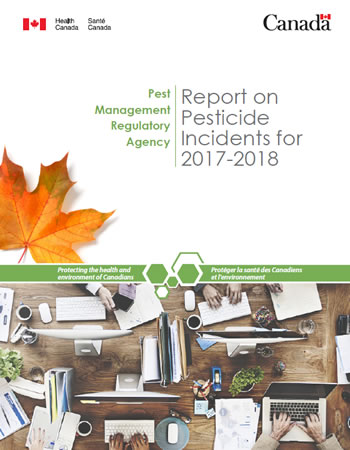Report on Pesticide Incidents for 2017-2018
Executive Summary
The Pest Management Regulatory Agency (PMRA) is the branch of Health Canada responsible for regulating pesticides under the authority of the Pest Control Products Act. PMRA’s primary mandate is to prevent unacceptable risks to health and the environment from the use of these products. The PMRA applies current, evidence-based scientific approaches to assess whether the health and environmental risks of pesticides proposed for registration are acceptable, and if the products have value.
This Report on Pesticide Incidents for 2017-18 provides a general overview of incident reports received during this period, and outlines the PMRA’s assessment of the more serious incidents, as well as incident evaluations that may be of notable interest to stakeholders and the public.
The PMRA has been collecting pesticide incident reports since 2007. Between 2007 and 2017, over 20 000 incidents were reported to the PMRA. In 2017-18, 2401 incident reports were submitted to the Agency. Domestic animal incidents were reported most frequently, followed by human and environment incidents. Most incidents involved minor effects.
The PMRA’s Incident Reporting Program uses incident information to assess potential risks to humans, domestic animals and the environment from use of pesticides. Priority is given to all incident reports that are serious in nature, involve multiple people or animals, or indicate a recurring problem with pesticide exposure. In addition, when the PMRA reviews new active ingredients or conducts re-evaluations of currently registered pesticides, a complete analysis of all incident reports involving that pesticide is integrated into the risk assessment. A weight-of-evidence approach is used to evaluate pesticide incident data. That is, many different sources of information, such as available scientific studies and adverse effects data, are considered and integrated into the assessment of pesticide incident information. If risks are identified, various protective actions are developed with the aim to reduce pesticide exposure and the occurrence of adverse effects. Such actions may include improved label language or user education and outreach initiatives.
The PMRA took several risk reduction measures as a result of the incident report data received in 2017-18. Measures of note:
- Regulatory changes were implemented for spot-on products used for the control of fleas and ticks on pets following an in-depth review of the domestic animal incident data. The approach outlined in PMRA Guidance Document, Label Improvements for Spot-on Pesticides Used on Companion Animals recommended informing consumers of the possible adverse health effects that may be expected in pets following spot-on product use by listing these on the product labels. As well, additional animal safety testing data requirements, as outlined in PMRA Guidance Document, Revisions to Data Requirements for Pesticide Products Used on Companion Animals, are required to better predict potential effects that may occur with the use of companion animal products.
- End-use product labels containing iron were modified in 2017-18 to reduce the likelihood that these pesticides would be accessible to pets.
- Label improvements were proposed for permethrin products (separate from spot-on flea and tick products) in order to minimize human exposure either during application or upon re-entry into treated areas. In addition, directions were added to restrict pet access to areas that are treated with a permethrin product.
- For commercial and domestic class products containing cyfluthrin, the label precautions section was amended to address the potential for respiratory effects identified in incident reports. Required actions include directing users to ventilate treated areas and listing potential adverse health effects on the product label.
Other 2017-18 activities included amending the Pest Control Products Incident Reporting Regulations. Amendments were proposed following PMRA internal program evaluation and interaction with industry stakeholders to clarify incident reporting requirements, reduce regulatory and administrative burden for industry and align many requirements with the United States Environmental Protection Agency. They will also make it easier for Health Canada to identify trends in incident reporting, analyze data and respond to identified risks. The amendments to the Pest Control Products Incident Reporting Regulations were published in the Canada Gazette, Part II on 12 June 2019.
Pesticide incident reports are an essential element of post-market monitoring. Under the Pest Control Products Incident Reporting Regulations, the PMRA will continue to collect and analyze incident report information to identify and characterize potential risks to humans, domestic animals, and the environment from the use of pesticides.
Note that a more detailed report of the 2017-18 pesticide incidents is available upon request.
Past Reports on Pesticide Incidents
To obtain a past Reports on Pesticide Incidents report from 2007 to 2014, please contact the Pest Management Information Service.
Page details
- Date modified:
